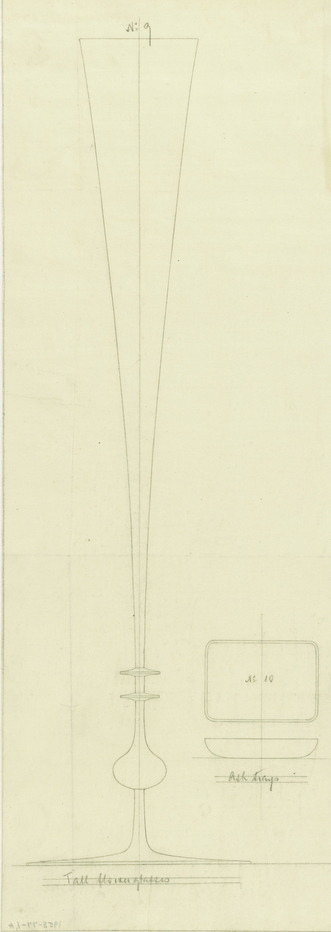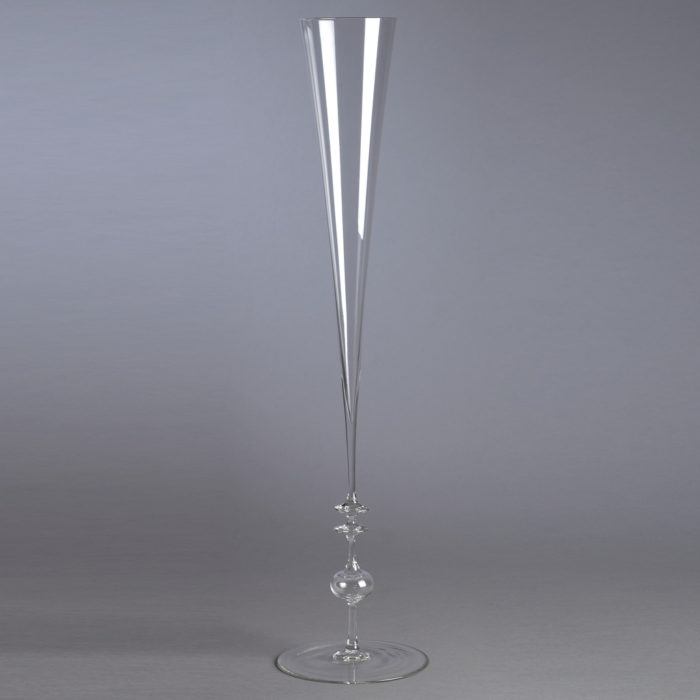This vase and drawing can been seen in the exhibition The Jazz Age: American Style in the 1920s, now on view through August 20, 2017.
This vase is a virtuosic performance in glass. An interpretation of a sixteenth-century Venetian vase, it epitomizes the technical achievements of the Lobmeyr glass firm and the geometric and smooth-surfaced designs of Oswald Haerdtl. More symbolic than useful, it celebrates the art of glassblowing.
Ludwig Lobmeyr, son of the founder of the firm, first used the plain, very thin glass called muslin glass in his 1856 beer tumbler both as a technical feat but also to contrast with the elaborate decoration of much glass of the era. However, in 1917, under the direction of his son-in-law and successor Stefan Rath, Lobmeyr further advanced the fineness of muslin glass, creating an ultra-thin muslin glass with a barely perceptible resilience and strength for Josef Hoffmann’s Patrician pattern. This pattern, of which a number of different sizes of stemmed glass are in the museum’s collection, uses the shape of the human lip to give sensuous curves to the glass. Both the cup and stem are barely felt by the lips and hand as the liquid slides into the mouth.
Some of Hoffmann’s glasses and rum flagons had iridescent hues, more subtle than Tiffany’s, a Lobmeyr technique started much earlier, since Lobmeyr was exhibiting iridescent glass at least by the Philadelphia Centennial Exhibition (1876), where Tiffany might have seen it. However it is in his use of clear glass in the Patrician pattern that Hoffmann shows a stronger modernist aesthetic that paves the way for Haerdtl’s colorless triumph of bold geometries whose almost only visible part is the outline.
The story of the user of this vase, along with a group of more functional table articles like wine and water goblets, plates and bowls, and bonbonnières (candy dishes) in various sizes, is one of the development of the International Style of the 1920s.

Figure 2: Drawing (detail), Design for Tall Flower Glasses, Ashtrays, Table Ornament, ca. 1926, Flower Glasses designed by Oswald Haerdtl, Ashtrays designed by Stefan Rath
This design and a number of others by Haerdtl were part of Lobmeyr’s display at the Paris 1925 Exposition internationale des arts décoratifs et industriels modernes. It was there that Mrs. Agnes Carpenter, a wealthy woman who lived on Fifth Avenue in New York, saw them. She ordered a large array of objects, and Lobmeyr sent design drawings for her approval, with even the names of the objects in English (Fig. 2). These drawings survive in the Drawings and Prints department, a rare example of Lobmeyr drawings outside the firm or the Museum of Applied Arts (MAK) in Vienna. Various entries in Lobmeyr’s account books confirm several orders from her in 1927 and 1928. Through her viewing of European design in world’s fairs, Agnes Carpenter helped bring the latest fashions to New York, although the necessary skills to make this glass remained in Austria. Carpenter’s collection came to Cooper Hewitt after her death in 1958. It was not until 2009, when Cooper Hewitt acquired a large collection of Lobmeyr glass directly from the Rath family descendant owners, that another Lobmeyr collection entered the museum, this time, with some examples designed by an American—Ted Muehling.
This essay is excerpted from the book Making Design, available through SHOP Cooper Hewitt.
This object was featured in our Object of the Day series in a post titled A Clearly Viennese Vase: Ambassador Vase by Oswald Haerdtl.
